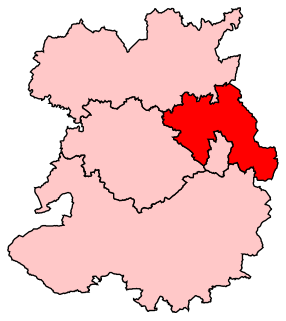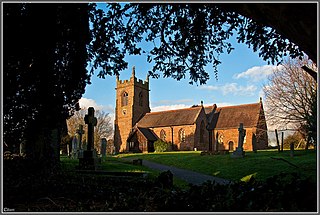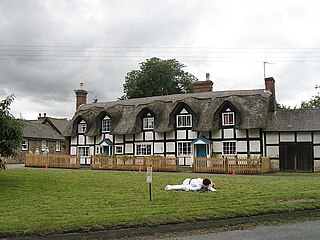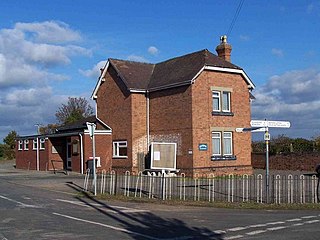
The Wrekin is a constituency in the House of Commons of the British Parliament, located in the county of Shropshire in the West Midlands of England. It has existed continuously since its creation by the Representation of the People Act 1918, and is named after a prominent landmark hill in the area, The Wrekin. The constituency has periodically swung back and forth between the Labour and Conservative parties since the 1920s, and has been held since 2005 by a Conservative MP, Mark Pritchard.

Roden is a hamlet in the borough of Telford and Wrekin and ceremonial county of Shropshire, England, six miles northeast of Shrewsbury. The little River Roden flows past the village. The population at the 2011 census can be found under High Ercall. Watercolour artist Thomas Frederick Worrall painted a view of the Wrekin from near where the B5062 road bends sharply and crosses the river Roden. The painting is available on the Watercolour World web site.

Laugharne Castle is a castle in the town of Laugharne in southern Carmarthenshire, Wales. It is located on the estuary of the River Tâf and was originally established in 1116. It was rebuilt as a Norman stronghold in 1215 and has seen many alterations over time, becoming a Tudor fortified manor house in the sixteenth century. It changed hands twice during the English Civil War, being eventually captured by Parliamentary forces in 1644.

Peplow is a hamlet in Shropshire, England. It is part of the civil parish of Hodnet, a larger village to the north. The hamlets of Bowling Green and Radmoor are both in the village's vicinity.

Child's Ercall is a village and civil parish in Shropshire, England. It is located in a rather remote rural area between the small towns of Market Drayton and Newport: the civil parish had a total population of 599 at the 2001 census, rising to 732 at the 2011 Census. The closest neighbouring village is Ollerton, around 1 mile to the west.

Brampton Bryan is a small village and civil parish situated in north Herefordshire, England close to the Shropshire and Welsh borders.

Moreton Corbet Castle is an English Heritage property located near the village of Moreton Corbet, Shropshire, England, 8 miles northeast of Shrewsbury. It is a Grade I listed building. The ruins are from two different eras: a medieval stronghold and an Elizabethan era manor house. The buildings have been out of use since the 18th century.

Hopton Castle is situated in the village of the same name which lies approximately halfway between Knighton and Craven Arms, in the English county of Shropshire. Hopton Castle featured in the British TV series Time Team in 2010. A ruin since the early 18th century, it was partially restored between 2006 and 2011, and was officially re-opened to the public as a visitor attraction in December 2011 by the Duke of Gloucester.

Ellerdine is a small hamlet located six miles north of the market town of Wellington, Shropshire.

Sodington Hall is an early 19th-century country house in the parish of Mamble in Worcestershire, England. The Grade II listed building was described by Nikolaus Pevsner as "neat and modest" and by James Lees-Milne in the Shell Worcestershire Guide as a "red brick dolls house".

Peplow Hall is a privately owned 11,635 square feet (1,080.9 m2), 18th-century country house at Peplow, near Hodnet, Shropshire. It is the seat of Lord Newborough and is a Grade II* listed building.

Longford is an ancient village near the town of Newport, Shropshire. It lies in the parish of Church Aston. Roman coins and medieval artifacts have been discovered in the village and it is listed in the Domesday Book 1066 with a population of 23 households, 13.5 plough lands and a mill. The historic manor covers 1,306 acres and includes the townships of Brockton and Stockton. Sites of historic importance include: Longford Hall, a late 16th-century dovecote, Church of St Mary, 13th century Talbot Chapel, remains of a mill race and several farm buildings.

Kinlet Hall is an 18th-century English country house at Kinlet, Shropshire, England, now occupied by an independent day and residential school. It is a Grade I listed building.

Mawley Hall is a privately owned 18th-century country mansion near Cleobury Mortimer, Shropshire, England. It is a Grade I listed building.

Goldstone is a small hamlet in eastern Shropshire, England, in the civil parish of Cheswardine. It lies in an isolated rural area north of Hinstock and Ellerton, around 5 miles south of the nearest town, Market Drayton.

Apley Castle was a medieval fortified manor in the village of Hadley, Shropshire, England.

Upton Cressett Hall is a Elizabethan moated manor house in the village of Upton Cressett, Shropshire, England. It is a Grade I-listed building.





















